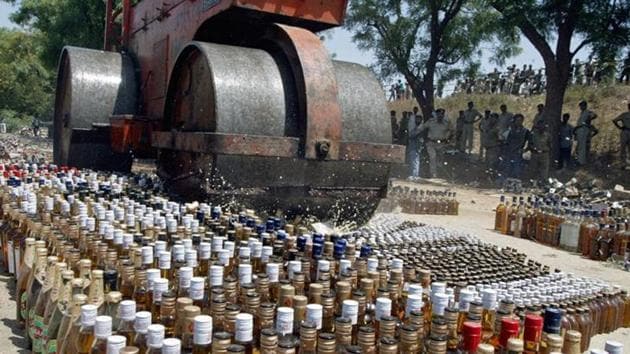Wary of prohibitionist church, Mizoram mum on liquor revenue
Excise and narcotics department has kept the data on total consumption of liquor and revenue earned confidential
The government in Christian-majority Mizoram does not want the church to know how much revenue it earns from liquor sale.

Reason: the booty from booze might alarm the influential church and prohibitionist NGOs enough to step up their demand for a return to dry days.
This demand is expected to be a major issue in the assembly election next year, with the ‘church-compliant’ opposition Mizo National Front (MNF) desperate to end the Congress’ run since 2008.
The MNF is a member of the BJP-helmed North East Democratic Alliance.
Lal Thanhawla’s Congress government had in July 2014 replaced the Mizoram Liquor (Total Prohibition) Act of 1995 with the Mizoram Liquor (Prohibition and Control) Act to end 18 years of church-enforced ban on drinking.
Prohibition was formally lifted in January 2015 and wine shops opened two months later.
“We have kept the data on total consumption of liquor and revenue earned confidential because of the church and some NGOs,” a senior officer of the state’s excise and narcotics department said, declining to be quoted.
The government expects to earn about Rs 200-crore a year from liquor sales through three state-owned warehouses. Revenue figures in various publications from time to time are guesstimates, officials said.
The department’s achievement chart, updated on its site, has accordingly blanked out the revenue collection columns against ‘foreign liquor and spirit’ and ‘fines and confiscation’.
The achievements include seizure of alcoholic beverages such as zu (country liquor) and India-made foreign liquor besides imported beer. The list suggests seizure of local liquor and bigger bottles of IMFL has declined since prohibition was lifted at the end of the 2014-15 fiscal.
“This is not only about revenue. The government has also refused to provide details of the liquor permit card-holders for a study the church has been conducting to assess the impact of lifting prohibition in Mizoram,” B Sangthanga, executive secretary of Mizoram Synod of the Presbyterian Church told HT.
The majority of 87% Christians in Mizoram are Presbyterians.
As of March this year, the state of 1.1 million people has 71,158 liquor card holders entitled to six 750ml IMFL bottles and 10 bottles each of wine and beer a month from 51 operational outlets.
The Synod, Sangthanga said, appointed nine academics from Mizoram University and a few colleges to study the impact of alcohol in the state. “We are compiling the reports they submitted for publication by the end of May,” he added.
The church’s study panel is believed to be a counter to a similar committee state excise minister R Lalzirliana had formed last year.
“The 27-member review and evaluation committee is looking into the advantages and disadvantages of opening wine shops in the state,” Lalzirliana told the 40-member state assembly in March.
Apart from the church, the ruling Congress has the MNF to contend with. The regional party, trying to stir Christian sentiments, has been organising rallies against the opening of liquor shops.
The MNF, which promised to impose prohibition again if voted to power in the 2018 state Assembly polls, demanded that the state government immediately close the wine shops.
“Hundreds of people have died after the opening of wine shops,” MNF veteran and former chief minister Zoramthanga said.
Liquor washing out drugs?
Justifying the lifting of prohibition two years ago, Lalzirliana said the alcohol ban since 1995 “only increased the sale of expensive spurious liquor” and “people who cannot do without drinks need to find good quality liquor at cheaper prices”.
The government had also said access to legitimate liquor could go a long way in checking drug abuse in Mizoram, which shares a 510km long border with Myanmar, one of three countries forming the Golden Triangle notorious for growing opium.
“Before liquor started flowing in Mizoram legally, the government said drug trafficking and abuse would reduce as a result. This is also a subject of study by our panel,” Sangthanga said.
According to the excise and narcotics department, there have been 1,412 drug deaths in Mizoram between April 1984 and March this year. At least 27 of them, including three women, died in the year prohibition ended.
“It is too early to say whether drug trafficking or drug abuse has come down in the last two years,” F Lalhminga, deputy commissioner (enforcement), said.
The department’s data show enforcement sleuths seized fewer quantities of certain contraband items last year than in 2015. They include restricted brain drugs such as Nitrazepam, Diazepam and Alprazolam prescribed by psychologists and painkillers such as Spasmo Proxyvon and Parvon Spas.
“One of the reasons is that the Indian government had banned manufacture of painkillers in 2013,” a spokesperson of the department said.
But the seizure of certain narcotic substances such as methamphetamine aka party drug, pseudoephedrine and ephedrine has increased.
“Peddlers use Mizoram as a conduit for these substances to and from Myanmar,” the spokesperson said.
Pseudoephedrine, a medicinal drug for treating sinusitis, is the raw material for manufacturing methamphetamine.
“Pseudoephedrine and ephedrine come from manufacturers in India to be smuggled out via Myanmar to meth factories on the China-Myanmar border. The meth produced there is low-grade but are smuggled through Mizoram to be sold in Muslim countries via Bangladesh,” an excise officer said.
The distance from the Myanmar border to the Bangladesh border through Mizoram is less than 100km at the narrowest stretch.
Get Current Updates on India News, Ram Navami Live Updates , Lok Sabha election 2024 live, Election 2024 along with Latest News and Top Headlines from India and around the world.




